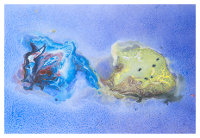Speaker
Vladimir Kovalenko
(St. Petersburg State University (RU))
Description
Studies of the collisions of various hadrons and nuclei at different centrality and energy enable to explore the QCD phase diagram over a wide range of temperature and baryon density in search of the critical point. In the framework of the string fusion approach [1] the critical behavior takes place when the processes of string fusion and percolation come into play, what can be considered as a possible way of Quark Gluon Plasma formation [2]. Around percolation threshold, strong fluctuations in colors of strings appear what lead to large fluctuations in some observables, which one can find by the event by event analysis.
In the present study, a Monte Carlo model [3] of proton-proton, proton-nucleus, and nucleus-nucleus collisions has been developed and applied to heavy and light ion collisions at the cms energy range from a few up to several hundred GeV per nucleon, where the critical effects are expected. The model takes into account both the string fusion and the finite rapidity length of strings, implementing the hadronic scattering through the interaction of color dipoles. It well describes the proton-nucleus and nucleus-nucleus collisions at the partonic level without using Glauber model of nuclear collisions. All parameters are fixed using experimental data on inelastic cross section and multiplicity. In the framework of the model, we performed a beam energy and system size scan and studied the behaviour of correlation and fluctuation observables. The detailed modeling of the event by event charged particles production allowed to provide predictions in the conditions close to the experimental ones and to make a direct comparison to the existing data.
The authors acknowledge Saint-Petersburg State University for the research grants 11.38.66.2012 and 11.38.197.2014. V. N. Kovalenko also acknowledges the support of Special SPbSU Rectors Scholarship and Dynasty Foundation Scholarship.
[1] N. S. Amelin, M. A. Braun and C. Pajares, Phys. Lett. B306, 312 (1993); Z. Phys. C63,507 (1994).
[2] M. A. Braun, C. Pajares, J. Ranft. Int. J. Mod. Phys. A 14 2689 (1999).
[3] V. N. Kovalenko. Phys. Atom. Nucl. 76, 1189 (2013), arXiv:1211.6209 [hep-ph]; V. Kovalenko, V. Vechernin. PoS (Baldin ISHEPP XXI) 077, arXiv:1212.2590 [nucl-th], 2012.
Author
Vladimir Kovalenko
(St. Petersburg State University (RU))
Co-author
Vladimir Vechernin
(St. Petersburg State University (RU))
